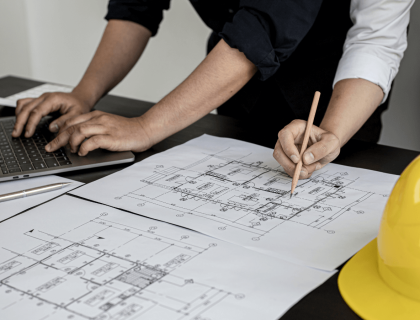What Is Building Information Modelling (BIM)?
Building Information Modelling (BIM) can be described as a process for creating and managing information throughout the entire lifecycle of a project.
It uses the latest in building technology to create and store a digital portfolio on every aspect of a build.
This includes generating 3D renders of each building asset and informative data used to guide a construction project from pre-planning all the way through to the final handover.
With labour and raw materials costs increasing rapidly and supply chain delays becoming commonplace, more and more projects are utilising BIM to improve efficiency.
The growing business case for BIM is reflected in its market growth with the industry expected to reach $9 billion in value by 2025.
The Building Information Modelling (BIM) Process
The BIM process starts with creating a 3D model of the building or infrastructure, which contains information about the structure’s geometry, such as its size, shape, and location, as well as the materials that will be used in construction.
Additionally, the model includes information about the building’s systems, such as plumbing, electrical, and HVAC, and how they interact with each other.
Once the 3D model is created, it can be utilized throughout the design process to test various options and scenarios.
For instance, architects can use the model to evaluate different design choices and envision how they will appear in the final building.
Engineers can use the model to simulate the building’s systems and detect potential issues.
Contractors can use the model to plan construction and identify potential conflicts between different trades.

Advantages of Building Information Modelling (BIM)
Improves Collaboration
The use of Building Information Modeling (BIM) can greatly enhance collaboration among stakeholders throughout the various stages of a building or infrastructure project, including planning, design, construction, and maintenance.
This is achieved by providing a central digital model that all parties can access and work on, leading to a more cohesive and efficient process.
With BIM, a digital replica of the building or infrastructure is generated, which can be utilized and modified by all parties involved in the project. This ensures that all stakeholders have access to the same information, minimizing the possibility of inaccuracies and miscommunications.
BIM also facilitates real-time sharing of information, opinions, and feedback among stakeholders. This improves communication among different teams and allows for early identification of potential problems, leading to a more efficient and successful project outcome.
Facilitates Better Decision Making
Building Information Modeling (BIM) can greatly enhance the decision-making process by providing a digital representation of the building or infrastructure that can be used to evaluate various design options and scenarios.
This enables architects, engineers, and contractors to evaluate the performance of the building, identify potential issues and make informed decisions based on accurate and reliable data.
One of the major benefits of BIM is the ability to simulate and analyze various design options.
This can assist in identifying issues that may not be evident during the design phase, such as structural deficiencies, thermal performance and energy efficiency.
For instance, architects can use BIM to assess different building layouts and materials to determine the most cost-effective and efficient design.
Engineers can use BIM to simulate the building’s systems and detect potential issues prior to construction.
Contractors can use BIM to plan the construction process and identify potential conflicts between different trades.

Increases Efficiency
Building Information Modelling (BIM) can significantly boost the efficiency of the design and construction process.
One way it does this is through automating many tasks that are typically completed manually, such as generating detailed schedules, material lists, and cost estimates.
This can save time and minimise the risk of errors, resulting in cost savings.
Another benefit of BIM is its ability to enhance coordination among different teams and trades involved in the construction process.
For example, BIM can be used to identify potential conflicts between different building systems, such as plumbing and electrical, before construction begins. This can decrease the chances of delays and rework, thereby saving time and money.
Furthermore, BIM can also be used to plan the construction process and identify potential roadblocks, helping to ensure that the project is completed on schedule.
Improves Sustainability
Building Information Modelling can greatly enhance the sustainability of a construction project in various ways.
One of the primary ways it does this is by enabling a more energy-efficient design.
BIM software can be employed to evaluate and optimize a building’s energy performance, and discover areas where energy savings can be made.
This can include things like the positioning of the building, the utilisation of natural light, and the choice of energy-efficient systems and equipment.
By identifying these possibilities early on, BIM can help to ensure that the building is as energy-efficient as possible.
Another way BIM can help to improve the sustainability of a construction project is through the selection of eco-friendly materials.
BIM software can be used to track the environmental impact of various materials and determine those with the lowest environmental impact.
This can include things like the embodied energy of the materials, their carbon footprint, and their potential for recycling or reuse.
By using BIM to identify sustainable materials, construction teams can make more informed decisions about the materials they use and help to reduce the environmental impact of the project.
Learn more about Environmental Product Declarations and the process for reporting the environmental impact of construction materials here.
Here are some key stats that further prove the value of Building Information Modelling
- Reduces general construction costs on average by 10%
- Reduces the probability of errors in budgeting on average by 40%
- Reduces construction time on average by more than 10%
Together with our sister company, Lawler Sustainability, Our mission at Lawler Consulting is to make our buildings more energy-efficient, cost-effective to operate, and sustainable.
If you are interested in our building engineering services, please contact us here.
Follow us on LinkedIn to keep up to date with all of our latest developments and industry trends.




